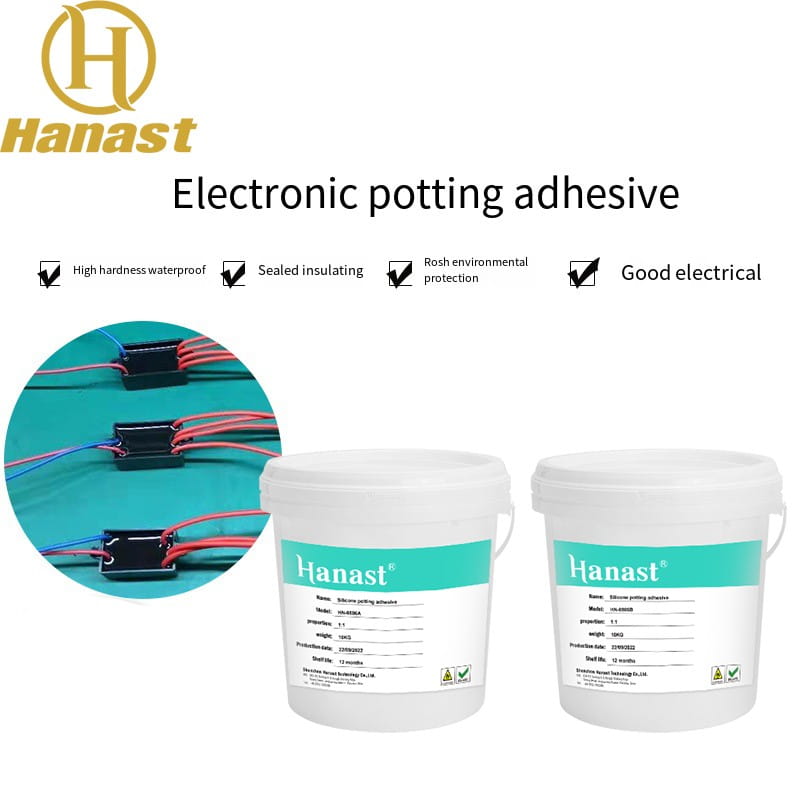The type, function, selection and usage of potting glue
 Apr 10,2023
Apr 10,2023

 Hanast
Hanast
Electronic potting glue is a material used for internal packaging of electronic products, usually made of epoxy resin, silicone, polyurethane and other materials. Its main function is to protect electronic components from moisture, vibration, pollutants and other environmental factors, and to improve the performance and reliability of electronic products. Electronic potting adhesive has the characteristics of high temperature resistance, chemical corrosion resistance, insulation and strong electric field resistance, and is widely used in automobiles, aerospace, medical equipment and other fields
There are many types of electronic potting adhesives, which can be divided into the following types according to different materials:
Epoxy resin potting compound: It has high strength, hardness and high temperature resistance, and is suitable for electronic products that require high mechanical strength and dimensional accuracy.
Polyurethane potting compound: It has good flexibility and anti-vibration performance, and is suitable for electronic products that need to resist external shocks.
Silicone potting compound: It has good high and low temperature resistance and chemical corrosion resistance, and is suitable for electronic products used in harsh environments.
Polyurethane-silicone composite potting compound: Combining the advantages of polyurethane and silica gel, it has the characteristics of high strength, vibration resistance and high and low temperature resistance.
Thermoplastic elastomer potting compound: It has good softness and resilience, and is suitable for electronic products that require frequent maintenance or replacement of components.
Different types of electronic potting adhesives have different advantages and disadvantages, the following are their main characteristics:
1. Epoxy resin potting glue
advantage:
High strength and hardness, can effectively protect internal components
Excellent high temperature resistance, suitable for electronic products in high temperature environment
shortcoming:
High brittleness, prone to cracks
Long curing time, it takes a certain amount of time to achieve the best effect
2. Polyurethane potting glue
advantage:
With good flexibility and anti-vibration performance, it can protect internal components from external shocks
Fast curing speed, can be put into use quickly
shortcoming:
Not resistant to high temperature, relatively narrow scope of application
Prone to corrosion and deformation after contact with some solvents and chemicals
3. Silicone potting glue
advantage:
Has good high and low temperature resistance and chemical corrosion resistance
Can be sealed waterproof, dustproof, etc., suitable for electronic products in various environments
shortcoming:
Low hardness, not suitable for electronic products requiring high strength
The curing time is long, you need to wait for a while to achieve the best effect
4. Polyurethane-silicone composite potting glue
advantage:
It has the advantages of polyurethane and silicone materials, and has better comprehensive performance
Excellent high and low temperature resistance, strong anti-vibration ability
shortcoming:
Relatively high cost, not suitable for cost-sensitive electronic products
Relatively low hardness, not suitable for electronic products requiring high strength
5. Thermoplastic elastomer potting compound
advantage:
Good flexibility and resilience, easy to disassemble and replace components
Allows fast curing at low temperatures, saving production time
shortcoming:
Relatively low strength and hardness, not suitable for electronic products requiring high strength
Chemical corrosion resistance is poor, can not be exposed to some chemicals
The specific formula and process of electronic potting adhesive can vary due to different materials and application scenarios. The following is a general electronic potting compound preparation process:
Material preparation: weigh epoxy resin, hardener, filler and other materials according to requirements, and mix them evenly in proportion.
Stirring: Stir the mixed material to make it more uniform.
Degassing: Put the stirred material into a vacuum chamber for degassing to remove air bubbles.
Potting: Pour the defoamed material into the electronic product for potting.
Curing: Allow the potted product to cure at the specified temperature and time.
Post-treatment: For products that need to be coated, surface coating treatment can be carried out to increase the appearance and durability of electronic products.
It should be noted that different types of electronic potting adhesives will have some differences in the preparation process. For example, silicone potting compounds need to be cured at lower temperatures, while epoxy potting compounds need to be cured at higher temperatures. Therefore, it needs to be adjusted according to the characteristics of the material and production requirements in actual operation.
Before using electronic potting glue for electronic product packaging, you need to pay attention to the following points:
Material quality: Choose materials with stable quality and follow the formula and process provided by the manufacturer.
Cleaning before potting: Before potting, electronic components need to be thoroughly cleaned to remove dirt and grease, so as not to affect the potting effect.
Packaging location: It is necessary to select the appropriate packaging location and method according to the structural characteristics and working conditions of the electronic product.
Curing time: The curing time of various electronic potting adhesives is different, and the curing time needs to be strictly controlled according to the requirements, otherwise the packaging effect will be affected.
Surface coating treatment: If it is necessary to carry out surface coating treatment on packaged electronic products, it is necessary to select appropriate coating materials and methods, otherwise the performance and reliability of the product may be affected.
Packaging quality inspection: After potting, the quality inspection of the product is required to check whether the packaging is complete and whether there is any air leakage. Repair or remake unqualified products in time.




 Home
Home
 【RTV Silicone Glue】What is it? What are the performance characteristics of RTV silicone rubber glue?
【RTV Silicone Glue】What is it? What are the performance characteristics of RTV silicone rubber glue?  You May Also Like
You May Also Like







 Tel
Tel
 Email
Email
 Address
Address












